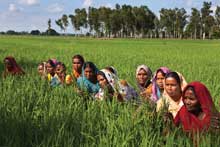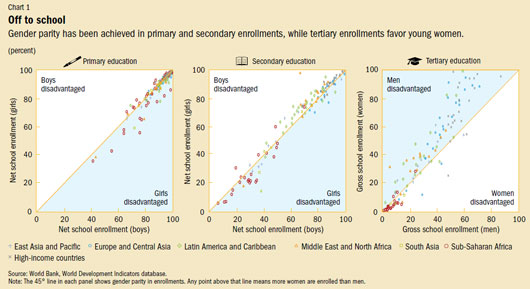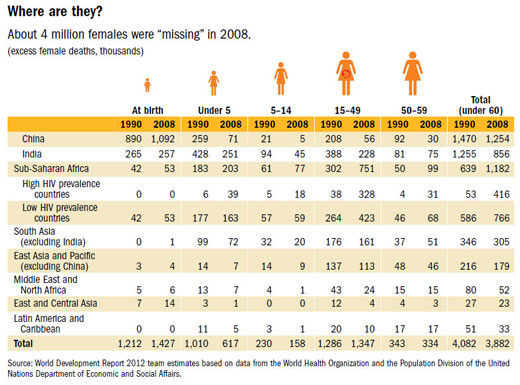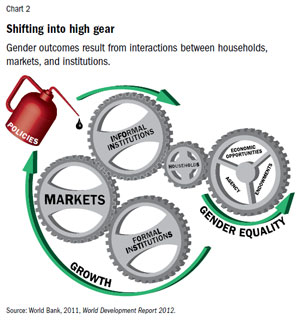Empowering Women Is Smart Economics
Finance & Development, March 2012, Vol. 49, No. 1
PDF version
![]() World Bank gender action plan:
World Bank gender action plan:
Liberia
Closing gender gaps benefits countries as a whole, not just women and girls

NOT long ago women faced tremendous barriers as they sought opportunities that would set them on an equal footing with men. Going back a mere quarter century, inequality between women and men was widely apparent—in university classrooms, in the workplace, and even in homes. Since then, the lives of women and girls around the world have improved dramatically in many respects. In most countries—rich and developing—they are going to school more, living longer, getting better jobs, and acquiring legal rights and protections.
But large gender gaps remain. Women and girls are more likely to die, relative to men and boys, in many low- and middle-income countries than their counterparts in rich countries. Women earn less and are less economically productive than men almost everywhere across the world. And women have less opportunity to shape their lives and make decisions than do men.
According to the World Bank’s 2012 World Development Report: Gender Equality and Development, closing these gender gaps matters for development and policymaking. Greater gender equality can enhance economic productivity, improve development outcomes for the next generation, and make institutions and policies more representative.
Many gender disparities remain even as countries develop, which calls for sustained and focused public action. Corrective policies will yield substantial development payoffs if they focus on persistent gender inequalities that matter most for welfare. To be effective, these measures must target the root causes of inequality without ignoring the domestic political economy.

Mixed progress
Every aspect of gender equality—access to education and health, economic opportunities, and voice within households and society—has experienced a mixed pattern of change over the past quarter century. In some areas, such as education, the gender gap has closed for almost all women; but progress has been slower for those who are poor and face other disadvantages, such as ethnicity. In other areas, the gap has been slow to close—even among well-off women and in countries that have otherwise developed rapidly.
In primary education, the gender gap has closed in almost all countries, and it is shrinking quickly in secondary education. Indeed, in almost one-third of developing countries, girls now outnumber boys in secondary schools. There are more young women than men in universities in two-thirds of the countries for which there are data: women today represent 51 percent of the world’s university students (see Chart 1). Yet more than 35 million girls do not attend school in developing countries, compared with 31 million boys, and two-thirds of these girls are members of ethnic minorities.

Since 1980, women have been living longer than men in all parts of the world. But across all developing countries, more women and girls still die at younger ages relative to men and boys, compared with rich countries. As a result of this “excess female mortality,” about 3.9 million girls and women under 60 are “missing” each year in developing countries (see table). About two-fifths of them are never born, one-sixth die in early childhood, and more than one-third die during their reproductive years. Female mortality is growing in sub-Saharan Africa, especially for women of childbearing age and in the countries hit hardest by the HIV/AIDS pandemic (World Bank, 2011, Chapter 3).

More than half a billion women have joined the world’s labor force over the past 30 years, and women now account for more than 40 percent of workers worldwide. One reason for increased workforce participation is an unprecedented reduction in fertility in developing countries as diverse as Bangladesh, Colombia, and the Islamic Republic of Iran, along with improvements in female education. Yet women everywhere tend to earn less than men (World Bank, 2011—especially Chapter 5). The reasons are varied. Women are more likely than men to work as unpaid family laborers or in the informal sector. Women farmers cultivate smaller plots and less profitable crops than male farmers. And women entrepreneurs operate smaller businesses in less lucrative sectors.
As for rights and voice, almost every country in the world has now ratified the Convention on the Elimination of All Forms of Discrimination Against Women. Yet, in many countries, women (especially poor women) have less say than men when it comes to decisions and resources in their households. Women are also much more likely to suffer domestic violence—in developing and rich countries. And in all countries, rich and poor alike, fewer women participate in formal politics, especially at higher levels.
Gender equality and development
Gender equality is important in its own right. Development is a process of expanding freedoms equally for all people—male and female (Sen, 2009). Closing the gap in well-being between males and females is as much a part of development as is reducing income poverty. Greater gender equality also enhances economic efficiency and improves other development outcomes. It does so in three main ways:
•First, with women now representing 40 percent of the global labor force and more than half the world’s university students, overall productivity will increase if their skills and talents are used more fully. For example, if women farmers have the same access as men to productive resources such as land and fertilizers, agricultural output in developing countries could increase by as much as 2.5 to 4 percent (FAO, 2011). Elimination of barriers against women working in certain sectors or occupations could increase output by raising women’s participation and labor productivity by as much as 25 percent in some countries through better allocation of their skills and talent (Cuberes and Teignier-Baqué, 2011).
•Second, greater control over household resources by women, either through their own earnings or cash transfers, can enhance countries’ growth prospects by changing spending in ways that benefit children. Evidence from countries as varied as Brazil, China, India, South Africa, and the United Kingdom shows that when women control more household income—either through their own earnings or through cash transfers—children benefit as a result of more spending on food and education (World Bank, 2011).
•Finally, empowering women as economic, political, and social actors can change policy choices and make institutions more representative of a range of voices. In India, giving power to women at the local level led to greater provision of public goods, such as water and sanitation, which mattered more to women (Beaman and others, 2011).
Gearing up development
How gender equality evolves as development proceeds can best be understood through the responses of households to the functioning and structure of markets and institutions—both formal (such as laws, regulations, and delivery of government services) and informal (such as gender roles, norms, and social networks).

Markets and institutions help determine the incentives, preferences, and constraints faced by different individuals in a household, as well as their voice and bargaining power. In this way, household decision making, markets, and formal and informal institutions interact to determine gender-related outcomes. This framework also helps show how economic growth (higher incomes) influences gender outcomes by affecting how markets and institutions work and how households make decisions. The impact of economic growth is shown in Chart 2 by the “growth” arrow that turns the gears in the direction of greater gender equality. The “gender equality” arrow shows how closing gender gaps in turn can contribute to higher growth.
This framework helps demonstrate why the gender gap in education enrollment has closed so quickly. In this case, income growth (by loosening budget constraints on households and the public treasury), markets (by opening new employment opportunities for women), and formal institutions (by expanding schools and lowering costs) have come together to influence household decisions in favor of educating girls and young women across a range of countries.
The framework also helps explain why poor women still face sizable gender gaps, especially those who experience not only poverty but also other forms of exclusion, such as living in a remote area, being a member of an ethnic minority, or suffering from a disability. In India and Pakistan, for instance, while there is no difference between the number of boys and girls enrolled in education for the richest fifth of the population, there is a gap of almost five years for the poorest fifth. The illiteracy rate among indigenous women in Guatemala is twice that among nonindigenous women and 20 percentage points higher than for indigenous men. Market signals, improved service delivery institutions, and higher incomes, which have generally favored the education of girls and young women, fail to reach these severely disadvantaged populations.
Policy implications
To bring about gender equality, policymakers need to focus their actions on five clear priorities: reducing the excess mortality of girls and women; eliminating remaining gender disadvantages in education; increasing women’s access to economic opportunity and thus earnings and productivity; giving women an equal voice in households and societies; and limiting the transmission of gender inequality across generations.
To reduce the excess mortality of girls and women, it is necessary to focus on the underlying causes at each age. Given girls’ higher susceptibility (relative to boys’) in infancy and early childhood to waterborne infectious diseases, improving water supply and sanitation, as Vietnam has done, is key to reducing excess female mortality in this age group (World Bank, 2011). Improving health care delivery to expectant mothers, as Sri Lanka did early in its development process and Turkey has done more recently, is critical. In the areas of sub-Saharan Africa most affected by the HIV/AIDS pandemic, broader access to antiretroviral drugs and reducing the incidence of new infections must be the focus. To counter sex-selective abortions that lead to fewer female births, most notably in China and northern India, the societal value of girls must be enhanced, as Korea has done.
To shrink education gaps in countries where they persist, barriers to access because of poverty, ethnicity, or geography must come down. For example, where distance is the key problem (as in rural areas of the Islamic Republic of Afghanistan), more schools in remote areas can reduce the gender gap. When customized solutions are hard to implement or too costly, demand-side interventions, such as cash transfers conditioned on school attendance, can help get girls from poor families to school. Such conditional cash transfers have succeeded in increasing girls’ enrollment rates in countries as diverse as Mexico, Turkey, and Pakistan (World Bank, 2011).
To broaden women’s access to economic opportunity, thereby reducing male-female disparity in earnings and economic productivity, a combination of policies is called for. Solutions include freeing up women’s time so they can work outside the home—for example, through subsidized child care, as in Colombia; improving women’s access to credit, as in Bangladesh; and ensuring access to productive resources—especially land—as in Ethiopia, where joint land titles are now granted to wives and husbands. Addressing lack of information about women’s productivity in the workplace and eliminating institutional biases against women, for example by introducing quotas that favor women or job placement programs as in Jordan, will also open up economic opportunity to women.
To diminish gender differences in household and societal voice, policies need to address the combined influence of social norms and beliefs, women’s access to economic opportunities, the legal framework, and women’s education. Measures that increase women’s control over household resources and laws that enhance their ability to accumulate assets, especially by strengthening their property rights, are important. Morocco’s recent family law reforms strengthened women’s property rights by equalizing husbands’ and wives’ ownership rights over property acquired during marriage. Ways to give women a greater voice in society include political representation quotas, training of future women leaders, and expanding women’s involvement in trade unions and professional associations.
To limit gender inequality over time, reaching adolescents and young adults is key. Decisions made during this stage of life determine skills, health, economic opportunities, and aspirations in adulthood. To ensure that gender gaps do not persist over time, policies must emphasize building human and social capital (as in Malawi with cash transfers given directly to girls to either stay in or return to school); easing the transition from school to work (as with job and life skills training programs for young women in Uganda); and shifting aspirations (by exposing girls to such role models as women political leaders in India).
Domestic policy action is crucial, but the international community can complement efforts in each of these priority areas. This will require new or additional action on multiple fronts—some combination of more funding, coordinated efforts to foster innovation and learning, and more effective partnerships. Funding should be directed particularly to the poorest countries’ efforts to reduce excess deaths of girls and women (through investment in clean water and sanitation and maternal services) and to reduce persistent education gender gaps. Partnerships must also extend beyond those between governments and development agencies to include the private sector, civil society organizations, and academic institutions in developing and rich countries.
And while so much remains to be done, in many ways the world has already changed by finally recognizing that gender equality is good for both women and men. More and more, we are all realizing that there are many benefits—economic and others—that will result from closing gender gaps. A man from Hanoi, Vietnam, one of thousands of people surveyed for the World Development Report, observed, “I think women nowadays increasingly enjoy more equality with men. They can do whatever job they like. They are very strong. In some families the wife is the most powerful person. In general, men still dominate, but women’s situation has greatly improved. Equal cooperation between husband and wife is happiness. I think happiness is when equality exist between a couple.” ■
Ana Revenga is Sector Director, Human Development, Europe and Central Asia; and Sudhir Shetty is Sector Director, Poverty Reduction and Economic Management, East Asia and Pacific, both at the World Bank.
This article is based on the World Development Report 2012: Gender Equality and Development, published by the World Bank in 2011. The evidence and analysis referred to are cited in the relevant sections of the report.
References
Beaman, Lori, Raghadendra Chattopadhya, Esther Duflo, Rohini Pande, and Petia Topalova, forthcoming, “Political Reservation and Substantive Representation: Evidence from Indian Village Councils,” 2011, in India Policy Forum 2010–11, ed. by Suman Bery, Barry Bosworth, and Arvind Panagariya (Washington: Brookings Institution and National Council of Applied Economic Research).
Cuberes, David, and Marc Teignier-Baqué, 2011, “Gender Equality and Economic Growth,” Background Paper for the World Development Report 2012.
Food and Agriculture Organization of the United Nations (FAO), 2011, The State of Food and Agriculture 2010–11: Women in Agriculture—Closing the Gender Gap for Development (Rome).
Sen, Amartya, 2009, Development as Freedom (New York: Anchor Books).
World Bank, 2011, World Development Report 2012: Gender Equality and Development (Washington).


